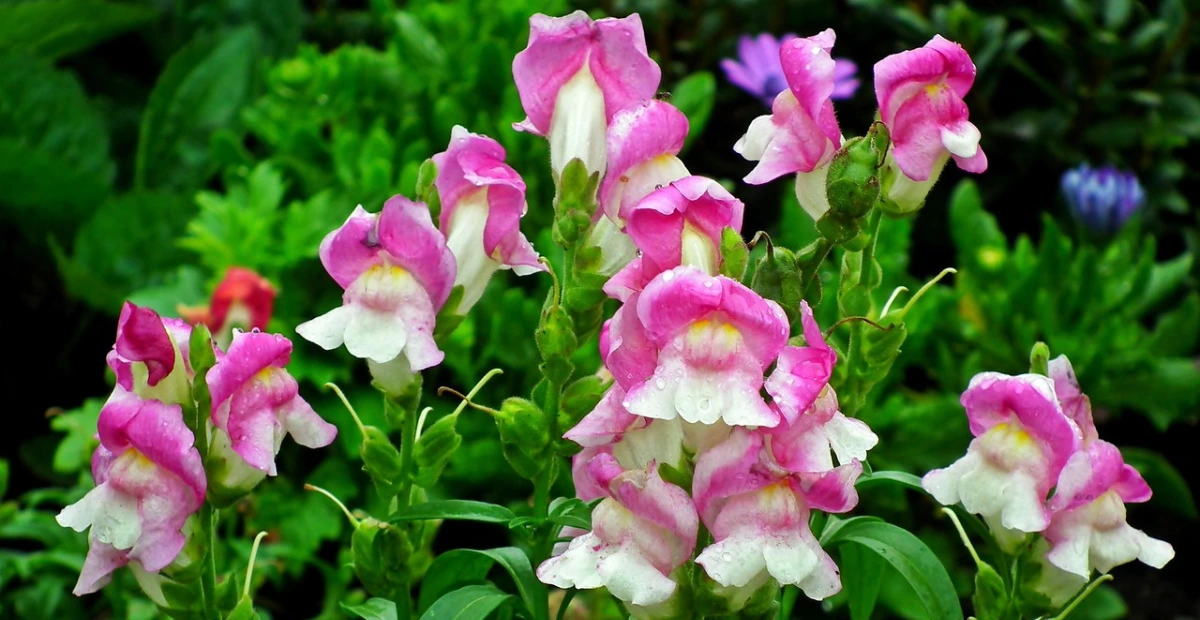Introduction
Have you ever come across a flower that simply takes your breath away? A bloom so graceful, so vibrant, that it instantly adds life to any space? If you haven’t yet discovered Chantilly Snapdragons, you’re in for a treat. These stunning flowers possess an unmatched elegance that can turn any garden or floral arrangement into a work of art. Whether you’re an experienced gardener or just beginning to explore the world of horticulture, planting Chantilly Snapdragons is an experience you won’t forget.
advertisement
Their delicate yet colorful blossoms bring joy, charm, and a sense of tranquility to any environment. But it’s not just their beauty that makes them so special—it’s their ease of care and versatility in the garden. In this guide, you’ll learn everything you need to know about Chantilly Snapdragons, from how to grow them to ways you can incorporate them into your garden or home décor.
Let’s explore how you can make Chantilly Snapdragons an essential part of your floral journey.
Table of Contents
What Are Chantilly Snapdragons?
The Origins and Unique Characteristics of Chantilly Snapdragons
Chantilly Snapdragons are part of the Antirrhinum family, but unlike the more common varieties, they stand out for their semi-double blooms. First introduced to the gardening world as a premium hybrid, Chantilly Snapdragons boast long-lasting flowers and a refined appearance. These plants are a product of thoughtful cross-breeding, designed to create a flower that could thrive in various climates while offering exquisite color and texture.
advertisement
While they may appear delicate, Chantilly Snapdragons are hardy and resilient. They grow in a variety of conditions, making them an excellent choice for gardeners across different regions. Their unique shape, with slightly ruffled edges, provides a sophisticated contrast to their bright, rich colors. Chantilly Snapdragons come in a variety of shades, including soft pastels, deep reds, and striking pinks, ensuring that they complement any garden theme.
In terms of size, these plants typically grow to a height of 18–30 inches, creating an elegant focal point in your garden. Their flowers tend to be longer-lasting compared to other snapdragons, making them ideal for both outdoor garden displays and indoor floral arrangements.
Color Range of Chantilly Snapdragons
One of the key features of Chantilly Snapdragons is their color palette. Available in a wide range of hues, these flowers can add both vibrancy and subtlety to your space. From soft lavender to brilliant coral, Chantilly Snapdragons give you the flexibility to create a beautiful garden or arrangement that matches your personal style.
advertisement
Here’s a look at some of the most popular color options:
- Pastel Pink: Soft, romantic, and subtle, perfect for elegant garden settings.
- Bright Red: A bold and striking color that adds energy to any arrangement.
- Peach and Coral: Warm tones that give a welcoming, sunny vibe to your garden.
- Lavender and Purple: Cool tones that pair beautifully with other garden plants.
How to Grow Chantilly Snapdragons
Ideal Growing Conditions
To ensure your Chantilly Snapdragons thrive, you need to plant them in the right environment. While these flowers are relatively low-maintenance, they have specific needs that must be met to ensure healthy growth and stunning blooms.
Climate: Chantilly Snapdragons are cool-season flowers, which means they prefer moderate temperatures. They grow best in USDA hardiness zones 4–8, where temperatures range from 50°F to 70°F (10°C to 21°C). If you live in a region with very hot summers, consider planting them in the early spring or fall to avoid the scorching heat.
Soil Type: These flowers thrive in well-drained soil. They prefer slightly acidic to neutral soil with a pH level between 6.0 and 7.0. Heavy clay or overly soggy soils should be avoided, as they can lead to root rot. If your soil is heavy, consider adding organic matter like compost or peat moss to improve drainage.
Sunlight Needs: Chantilly Snapdragons love the sun. They need at least 4–6 hours of direct sunlight each day for optimal growth. However, in regions with intense summer heat, a bit of afternoon shade can help protect them from stress and sunburn.
advertisement
Planting Chantilly Snapdragons
Planting Chantilly Snapdragons is a straightforward process, but there are a few things you should keep in mind to ensure your flowers get off to the best start.
When to Plant: The best time to plant Chantilly Snapdragons is in the early spring, after the last frost has passed. If you’re planting them from seeds, start them indoors 8–10 weeks before your last expected frost date. This allows the plants to establish strong roots before being moved outside.
Spacing and Depth: When planting Chantilly Snapdragons, make sure to space them about 12–18 inches apart. This gives them room to grow and ensures good air circulation around the plants. Dig holes about the same depth as the root ball, making sure not to plant them too deep. The top of the root ball should be level with the soil surface.
How to Plant: If you’re planting from seeds, sow them lightly on the surface of the soil and gently press them in. Cover them with a thin layer of soil and keep them moist until germination. If you’re transplanting seedlings, dig a hole that’s just big enough for the root ball, and gently place the plant in. Water well after planting.
advertisement
Watering and Fertilizing Chantilly Snapdragons
Chantilly Snapdragons have moderate water needs. While they don’t like being too wet, they also don’t thrive in drought conditions. It’s important to keep the soil consistently moist, but never soggy. Water them deeply, making sure that the water reaches the root zone.
Watering Needs: Water your plants in the morning, allowing the soil to dry out by evening. This reduces the risk of fungal diseases. During dry spells, you may need to water more frequently. However, make sure to avoid wetting the foliage, as this can lead to mildew.
Fertilization: To promote healthy growth and more vibrant blooms, Chantilly Snapdragons benefit from regular feeding. Use a balanced fertilizer every 4–6 weeks during the growing season. A slow-release granular fertilizer works well, or you can opt for liquid fertilizers that are diluted to half-strength.
Mulching: Applying a layer of mulch around the base of the plant helps retain moisture and keeps the roots cool, especially during the summer months. Organic mulch such as straw, bark, or compost works best.
Caring for Chantilly Snapdragons
Pruning and Deadheading
To keep your Chantilly Snapdragons looking their best, regular pruning and deadheading are essential. Removing dead flowers will not only keep your garden looking tidy but will also encourage more blooms.
advertisement
Why Prune? Pruning helps maintain the shape and size of the plant, ensuring that it doesn’t become too leggy or unkempt. Regularly trimming back any damaged or diseased parts also prevents the spread of pests and diseases.
Deadheading: As the flowers begin to fade, use a sharp pair of scissors or pruning shears to remove the spent blooms. Cut the stem just above a set of healthy leaves or a new bud to encourage further flowering. If you leave spent blooms on the plant, it can prevent the plant from producing new flowers.
When to Prune: The best time to prune Chantilly Snapdragons is early in the growing season before they bloom. After that, you can perform light pruning throughout the blooming season to keep the plant looking its best.
Managing Pests and Diseases
Like all plants, Chantilly Snapdragons are vulnerable to pests and diseases. However, by following proper care techniques, you can minimize the risk of issues.
Common Pests: Aphids and slugs are common pests that may attack Chantilly Snapdragons. Aphids can be controlled with insecticidal soap or neem oil. Slugs can be kept at bay with copper tape or natural slug repellents.
Common Diseases: Powdery mildew is a common issue, especially in humid environments. Ensure good air circulation by spacing the plants correctly and avoid wetting the leaves when watering. If mildew does appear, you can treat it with a fungicide or a homemade solution of baking soda and water.
advertisement
Creative Ways to Use Chantilly Snapdragons
Floral Arrangements and Bouquets
Chantilly Snapdragons are not only beautiful in the garden—they also make fantastic additions to floral arrangements. Their tall, upright stems add height and structure to bouquets, while their soft petals lend a delicate touch.
Cutting Flowers: When cutting Chantilly Snapdragons for floral arrangements, be sure to use sharp scissors or shears to avoid damaging the stems. Cut the stems at an angle, and place the flowers immediately in water to prevent air bubbles from forming in the stems.
Bouquet Ideas: Chantilly Snapdragons look stunning when paired with other seasonal flowers like roses, lilies, or daisies. They also make a great centerpiece for weddings and special occasions.
Longevity in Arrangements: To keep your Chantilly Snapdragons fresh longer, change the water in your vase every two days, and trim the stems slightly each time. This helps to prolong the life of your flowers.
Enhancing Your Garden with Chantilly Snapdragons
Chantilly Snapdragons can be a key feature of your garden design, whether you’re creating a formal flower bed or a more natural, relaxed look.
Border Planting: These flowers work well as border plants. Their height and color contrast beautifully with low-growing flowers, creating a layered effect in your garden.
Companion Plants: Chantilly Snapdragons pair beautifully with other cool-season flowers like pansies, violas, or sweet peas. For a warm-toned look, try planting them alongside marigolds or begonias.
advertisement
Container Gardening: If you have limited space, Chantilly Snapdragons are also perfect for container gardening. Plant them in a pot, and place them on your patio or balcony to enjoy their vibrant beauty all season long.
FAQ About Chantilly Snapdragons
What are the best growing conditions for Chantilly Snapdragons?
Chantilly Snapdragons thrive in moderate temperatures (50°F to 70°F), well-drained, slightly acidic soil, and full to partial sunlight.
How long do Chantilly Snapdragons bloom?
Chantilly Snapdragons bloom for several weeks, typically from spring to early summer. Regular deadheading can help extend their flowering period.
Can I grow Chantilly Snapdragons indoors?
Yes, you can grow Chantilly Snapdragons indoors, as long as they have access to plenty of sunlight and the right temperature conditions.
How do I keep Chantilly Snapdragons from getting leggy?
To prevent leggy growth, make sure your plants receive adequate sunlight, space them properly for good air circulation, and regularly prune or pinch back any long stems.
Conclusion: Your Garden’s New Favorite Flower
Chantilly Snapdragons are more than just flowers; they’re a statement of beauty and elegance. Whether you’re planting them for their stunning appearance or their versatility in both the garden and floral arrangements, these flowers are sure to bring joy to your life. With a little care and attention, your Chantilly Snapdragons will flourish, providing you with season after season of vibrant blooms.
Ready to add some elegance to your garden? Start planting Chantilly Snapdragons today and enjoy the beauty they bring!


